2017 KIA SEDONA heating
[x] Cancel search: heatingPage 428 of 586
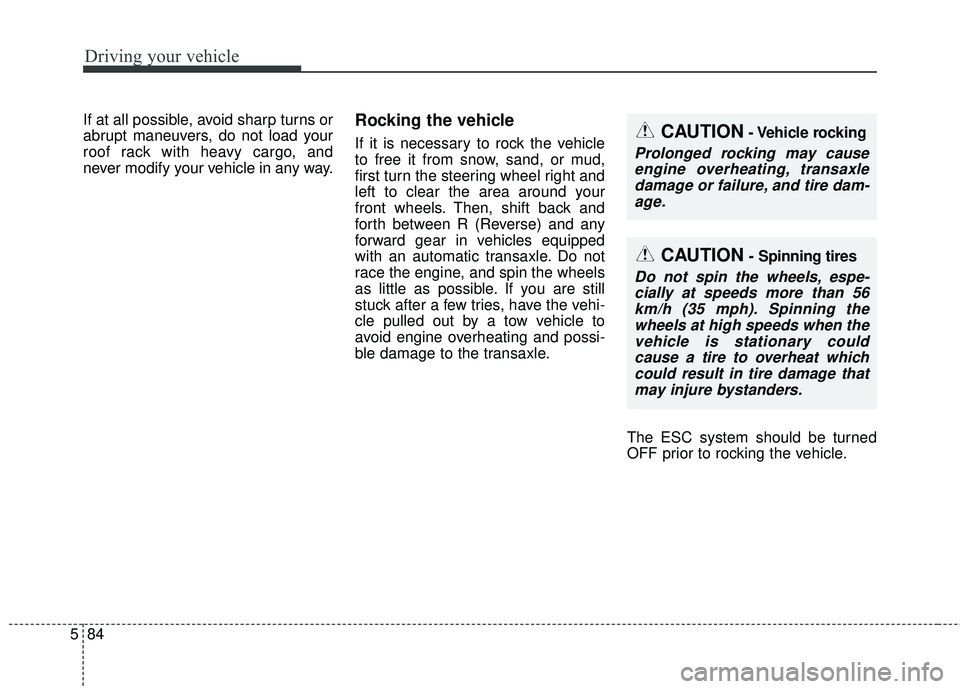
Driving your vehicle
84
5
If at all possible, avoid sharp turns or
abrupt maneuvers, do not load your
roof rack with heavy cargo, and
never modify your vehicle in any way.Rocking the vehicle
If it is necessary to rock the vehicle
to free it from snow, sand, or mud,
first turn the steering wheel right and
left to clear the area around your
front wheels. Then, shift back and
forth between R (Reverse) and any
forward gear in vehicles equipped
with an automatic transaxle. Do not
race the engine, and spin the wheels
as little as possible. If you are still
stuck after a few tries, have the vehi-
cle pulled out by a tow vehicle to
avoid engine overheating and possi-
ble damage to the transaxle.
The ESC system should be turned
OFF prior to rocking the vehicle.CAUTION- Vehicle rocking
Prolonged rocking may causeengine overheating, transaxledamage or failure, and tire dam-age.
CAUTION- Spinning tires
Do not spin the wheels, espe-cially at speeds more than 56km/h (35 mph). Spinning thewheels at high speeds when thevehicle is stationary couldcause a tire to overheat whichcould result in tire damage thatmay injure bystanders.
Page 431 of 586
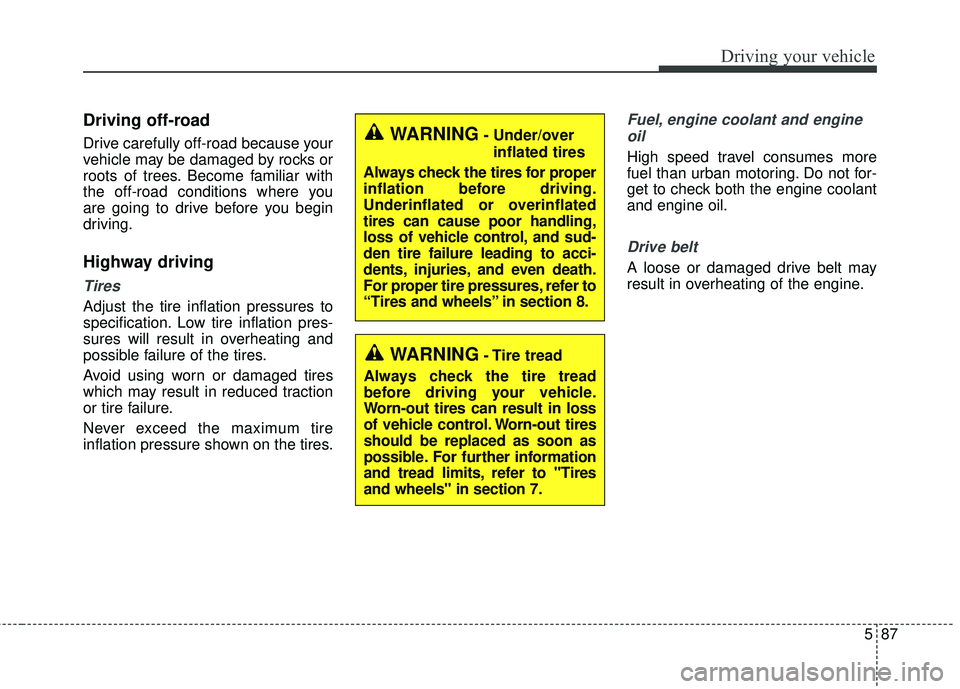
587
Driving your vehicle
Driving off-road
Drive carefully off-road because your
vehicle may be damaged by rocks or
roots of trees. Become familiar with
the off-road conditions where you
are going to drive before you begin
driving.
Highway driving
Tires
Adjust the tire inflation pressures to
specification. Low tire inflation pres-
sures will result in overheating and
possible failure of the tires.
Avoid using worn or damaged tires
which may result in reduced traction
or tire failure.
Never exceed the maximum tire
inflation pressure shown on the tires.
Fuel, engine coolant and engineoil
High speed travel consumes more
fuel than urban motoring. Do not for-
get to check both the engine coolant
and engine oil.
Drive belt
A loose or damaged drive belt may
result in overheating of the engine.
WARNING- Under/over inflated tires
Always check the tires for proper
inflation before driving.
Underinflated or overinflated
tires can cause poor handling,
loss of vehicle control, and sud-
den tire failure leading to acci-
dents, injuries, and even death.
For proper tire pressures, refer to
“Tires and wheels” in section 8.
WARNING- Tire tread
Always check the tire tread
before driving your vehicle.
Worn-out tires can result in loss
of vehicle control. Worn-out tires
should be replaced as soon as
possible. For further information
and tread limits, refer to "Tires
and wheels" in section 7.
Page 438 of 586
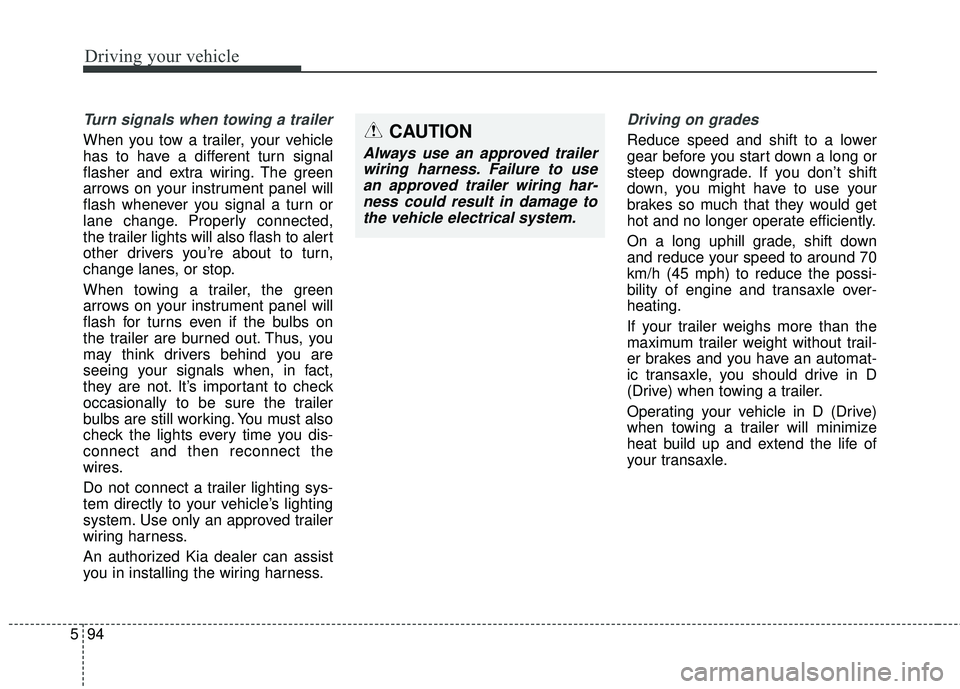
Driving your vehicle
94
5
Turn signals when towing a trailer
When you tow a trailer, your vehicle
has to have a different turn signal
flasher and extra wiring. The green
arrows on your instrument panel will
flash whenever you signal a turn or
lane change. Properly connected,
the trailer lights will also flash to alert
other drivers you’re about to turn,
change lanes, or stop.
When towing a trailer, the green
arrows on your instrument panel will
flash for turns even if the bulbs on
the trailer are burned out. Thus, you
may think drivers behind you are
seeing your signals when, in fact,
they are not. It’s important to check
occasionally to be sure the trailer
bulbs are still working. You must also
check the lights every time you dis-
connect and then reconnect the
wires.
Do not connect a trailer lighting sys-
tem directly to your vehicle’s lighting
system. Use only an approved trailer
wiring harness.
An authorized Kia dealer can assist
you in installing the wiring harness.
Driving on grades
Reduce speed and shift to a lower
gear before you start down a long or
steep downgrade. If you don’t shift
down, you might have to use your
brakes so much that they would get
hot and no longer operate efficiently.
On a long uphill grade, shift down
and reduce your speed to around 70
km/h (45 mph) to reduce the possi-
bility of engine and transaxle over-
heating.
If your trailer weighs more than the
maximum trailer weight without trail-
er brakes and you have an automat-
ic transaxle, you should drive in D
(Drive) when towing a trailer.
Operating your vehicle in D (Drive)
when towing a trailer will minimize
heat build up and extend the life of
your transaxle.CAUTION
Always use an approved trailer
wiring harness. Failure to usean approved trailer wiring har-ness could result in damage tothe vehicle electrical system.
Page 439 of 586
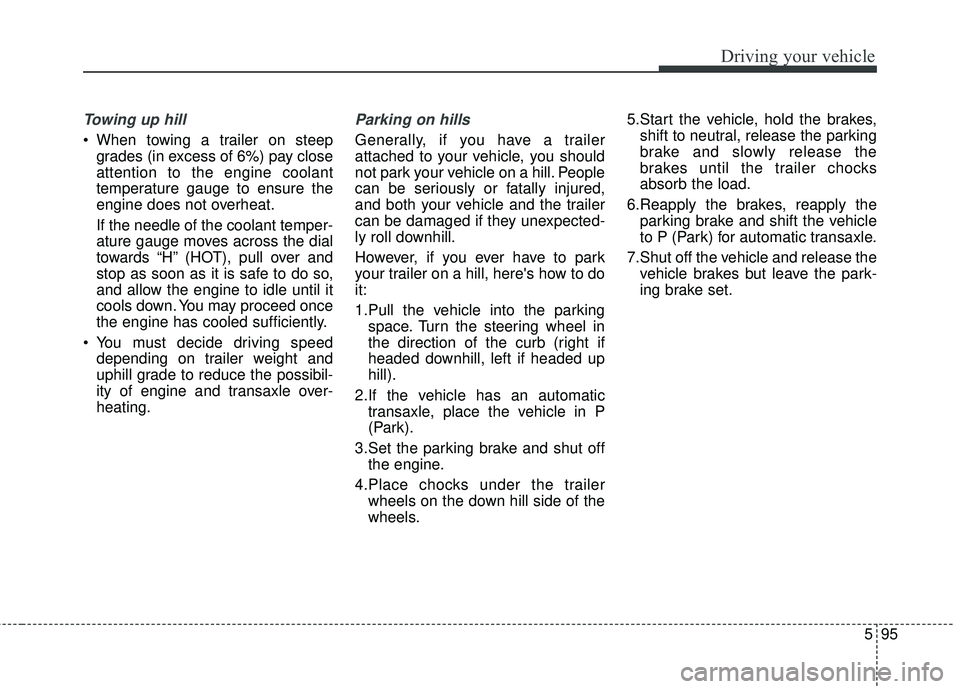
595
Driving your vehicle
Towing up hill
When towing a trailer on steepgrades (in excess of 6%) pay close
attention to the engine coolant
temperature gauge to ensure the
engine does not overheat.
If the needle of the coolant temper-
ature gauge moves across the dial
towards “H” (HOT), pull over and
stop as soon as it is safe to do so,
and allow the engine to idle until it
cools down. You may proceed once
the engine has cooled sufficiently.
You must decide driving speed depending on trailer weight and
uphill grade to reduce the possibil-
ity of engine and transaxle over-
heating.
Parking on hills
Generally, if you have a trailer
attached to your vehicle, you should
not park your vehicle on a hill. People
can be seriously or fatally injured,
and both your vehicle and the trailer
can be damaged if they unexpected-
ly roll downhill.
However, if you ever have to park
your trailer on a hill, here's how to do
it:
1.Pull the vehicle into the parkingspace. Turn the steering wheel in
the direction of the curb (right if
headed downhill, left if headed up
hill).
2.If the vehicle has an automatic transaxle, place the vehicle in P
(Park).
3.Set the parking brake and shut off the engine.
4.Place chocks under the trailer wheels on the down hill side of the
wheels. 5.Start the vehicle, hold the brakes,
shift to neutral, release the parking
brake and slowly release the
brakes until the trailer chocks
absorb the load.
6.Reapply the brakes, reapply the parking brake and shift the vehicle
to P (Park) for automatic transaxle.
7.Shut off the vehicle and release the vehicle brakes but leave the park-
ing brake set.
Page 440 of 586
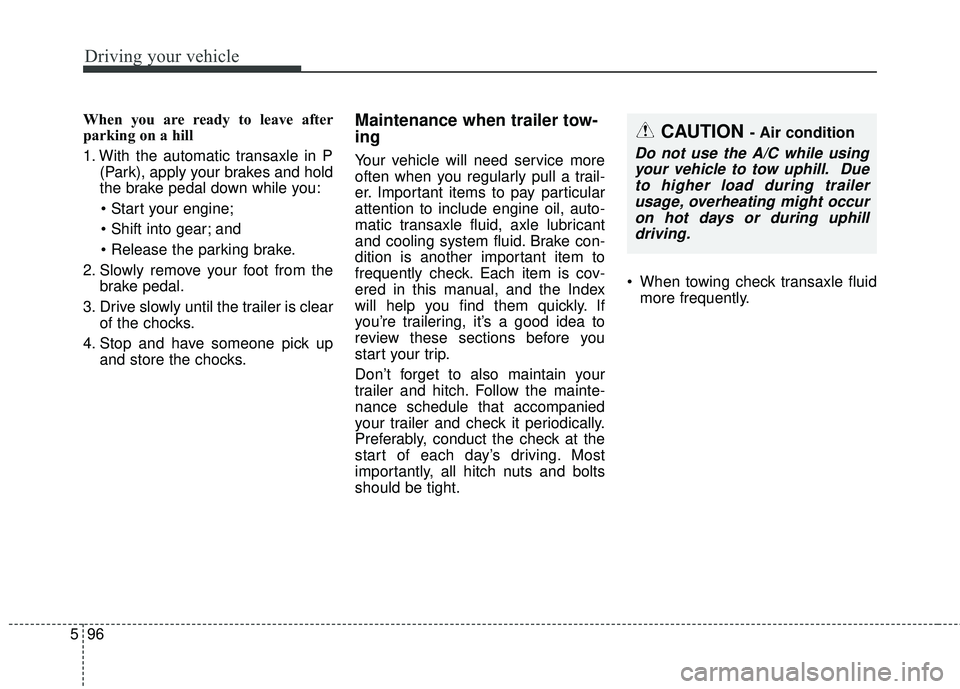
Driving your vehicle
96
5
When you are ready to leave after
parking on a hill
1. With the automatic transaxle in P
(Park), apply your brakes and hold
the brake pedal down while you:
and
2. Slowly remove your foot from the brake pedal.
3. Drive slowly until the trailer is clear of the chocks.
4. Stop and have someone pick up and store the chocks.Maintenance when trailer tow-
ing
Your vehicle will need service more
often when you regularly pull a trail-
er. Important items to pay particular
attention to include engine oil, auto-
matic transaxle fluid, axle lubricant
and cooling system fluid. Brake con-
dition is another important item to
frequently check. Each item is cov-
ered in this manual, and the Index
will help you find them quickly. If
you’re trailering, it’s a good idea to
review these sections before you
start your trip.
Don’t forget to also maintain your
trailer and hitch. Follow the mainte-
nance schedule that accompanied
your trailer and check it periodically.
Preferably, conduct the check at the
start of each day’s driving. Most
importantly, all hitch nuts and bolts
should be tight. When towing check transaxle fluid
more frequently.
CAUTION - Air condition
Do not use the A/C while usingyour vehicle to tow uphill. Dueto higher load during trailerusage, overheating might occuron hot days or during uphilldriving.
Page 456 of 586
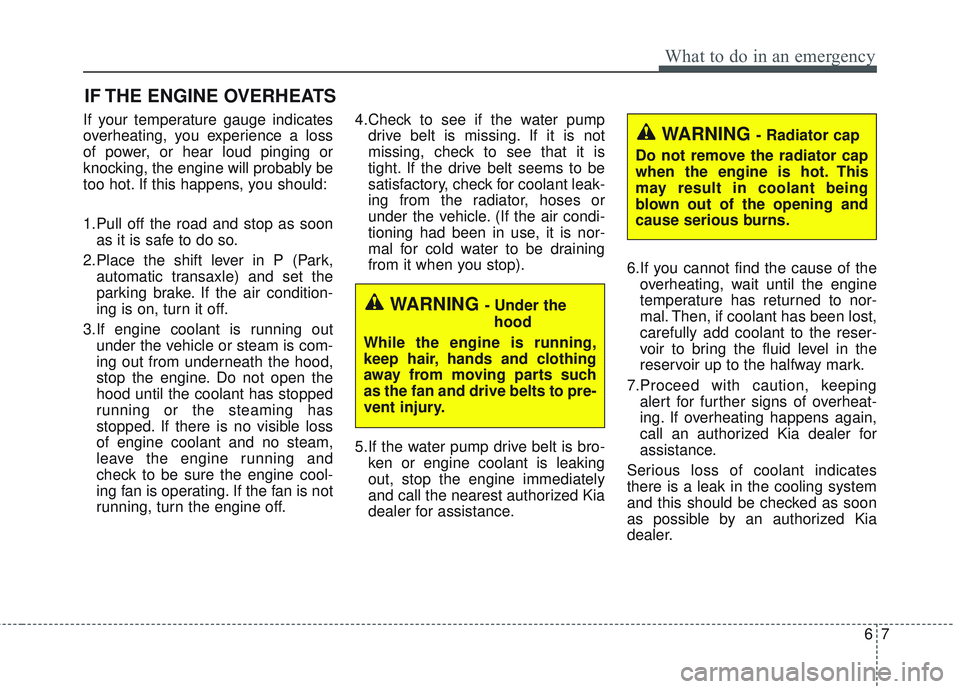
67
What to do in an emergency
IF THE ENGINE OVERHEATS
If your temperature gauge indicates
overheating, you experience a loss
of power, or hear loud pinging or
knocking, the engine will probably be
too hot. If this happens, you should:
1.Pull off the road and stop as soonas it is safe to do so.
2.Place the shift lever in P (Park, automatic transaxle) and set the
parking brake. If the air condition-
ing is on, turn it off.
3.If engine coolant is running out under the vehicle or steam is com-
ing out from underneath the hood,
stop the engine. Do not open the
hood until the coolant has stopped
running or the steaming has
stopped. If there is no visible loss
of engine coolant and no steam,
leave the engine running and
check to be sure the engine cool-
ing fan is operating. If the fan is not
running, turn the engine off. 4.Check to see if the water pump
drive belt is missing. If it is not
missing, check to see that it is
tight. If the drive belt seems to be
satisfactory, check for coolant leak-
ing from the radiator, hoses or
under the vehicle. (If the air condi-
tioning had been in use, it is nor-
mal for cold water to be draining
from it when you stop).
5.If the water pump drive belt is bro- ken or engine coolant is leaking
out, stop the engine immediately
and call the nearest authorized Kia
dealer for assistance. 6.If you cannot find the cause of the
overheating, wait until the engine
temperature has returned to nor-
mal. Then, if coolant has been lost,
carefully add coolant to the reser-
voir to bring the fluid level in the
reservoir up to the halfway mark.
7.Proceed with caution, keeping alert for further signs of overheat-
ing. If overheating happens again,
call an authorized Kia dealer for
assistance.
Serious loss of coolant indicates
there is a leak in the cooling system
and this should be checked as soon
as possible by an authorized Kia
dealer.
WARNING - Under the hood
While the engine is running,
keep hair, hands and clothing
away from moving parts such
as the fan and drive belts to pre-
vent injury.
WARNING - Radiator cap
Do not remove the radiator cap
when the engine is hot. This
may result in coolant being
blown out of the opening and
cause serious burns.
Page 578 of 586

Index
2I
Active ECO system. . . . . . . . . . . . . . . . . . . . . . . . . . . . 5-66Active ECO operation . . . . . . . . . . . . . . . . . . . . . . . 5-66
Limitation of Active ECO operation . . . . . . . . . . . . 5-66
When Active ECO is activated . . . . . . . . . . . . . . . . . 5-66
Air bag - advanced supplemental restraint system . . . . 3-59 Air bag warning label. . . . . . . . . . . . . . . . . . . . . . . . 3-86
Air bag warning light . . . . . . . . . . . . . . . . . . . . . . . . 3-62
Curtain air bag . . . . . . . . . . . . . . . . . . . . . . . . . . . . . 3-78
Driver's and passenger's front air bag . . . . . . . . . . . 3-73
How does the air bag system operate . . . . . . . . . . . 3-60
Occupant Detection System(ODS) . . . . . . . . . . . . . 3-66
Side air bag. . . . . . . . . . . . . . . . . . . . . . . . . . . . . . . . 3-76
SRS Care . . . . . . . . . . . . . . . . . . . . . . . . . . . . . . . . . 3-85
SRS components and functions . . . . . . . . . . . . . . . . 3-63
Air cleaner . . . . . . . . . . . . . . . . . . . . . . . . . . . . . . . . . . 7-38\
Filter replacement. . . . . . . . . . . . . . . . . . . . . . . . . . . 7-38
Air conditioning system . . . . . . . . . . . . . . . . . . . . . . . . . 8-5
Appearance care . . . . . . . . . . . . . . . . . . . . . . . . . . . . . . 7-85 Exterior care . . . . . . . . . . . . . . . . . . . . . . . . . . . . . . . 7-85
Interior care . . . . . . . . . . . . . . . . . . . . . . . . . . . . . . . 7-91
Audio . . . . . . . . . . . . . . . . . . . . . . . . . . . . . . . . . . . . \
. 4-206 Feature of Your Audio . . . . . . . . . . . . . . . . . . . . . . 4-207
Media . . . . . . . . . . . . . . . . . . . . . . . . . . . . . . . . . . . 4-\
216
Phone . . . . . . . . . . . . . . . . . . . . . . . . . . . . . . . . . . . 4-\
230
Radio . . . . . . . . . . . . . . . . . . . . . . . . . . . . . . . . . . . 4-\
213
Setup . . . . . . . . . . . . . . . . . . . . . . . . . . . . . . . . . . . . \
4-240 Siri . . . . . . . . . . . . . . . . . . . . . . . . . . . . . . . . . . . . \
. 4-239
SiriusXM . . . . . . . . . . . . . . . . . . . . . . . . . . . . . . . . 4-214
Audio system . . . . . . . . . . . . . . . . . . . . . . . . . . . . . . . 4-201 Antenna . . . . . . . . . . . . . . . . . . . . . . . . . . . . . . . . . 4-201
AUX, USB port . . . . . . . . . . . . . . . . . . . . . . . . . . . 4-201
How vehicle audio works . . . . . . . . . . . . . . . . . . . . 4-202
Automatic climate control system . . . . . . . . . . . . . . . 4-162 Automatic heating and air conditioning. . . . . . . . . 4-163
Checking the amount of air conditionerrefrigerant and compressor lubricant . . . . . . . . . . 4-179
Climate control air filter. . . . . . . . . . . . . . . . . . . . . 4-178
From the front seat . . . . . . . . . . . . . . . . . . . . . . . . . 4-173
From the rear seat. . . . . . . . . . . . . . . . . . . . . . . . . . 4-173
Manual heating and air conditioning . . . . . . . . . . . 4-164
Outside thermometer . . . . . . . . . . . . . . . . . . . . . . . 4-168
Rear climate control . . . . . . . . . . . . . . . . . . . . . . . . 4-173
System operation . . . . . . . . . . . . . . . . . . . . . . . . . . 4-176
Automatic transaxle . . . . . . . . . . . . . . . . . . . . . . . . . . . 5-13 Automatic transaxle operation . . . . . . . . . . . . . . . . . 5-13
Good driving practices . . . . . . . . . . . . . . . . . . . . . . . 5-18
Autonomous emergency braking (AEB) . . . . . . . . . . . 5-33 AEB Front Radar Sensor . . . . . . . . . . . . . . . . . . . . . 5-38
AEB Warning Message and System Control . . . . . . 5-35
Limitations of the System . . . . . . . . . . . . . . . . . . . . 5-41
System Malfunction . . . . . . . . . . . . . . . . . . . . . . . . . 5-39
System Setting and Activation . . . . . . . . . . . . . . . . . 5-33
A
Page 582 of 586
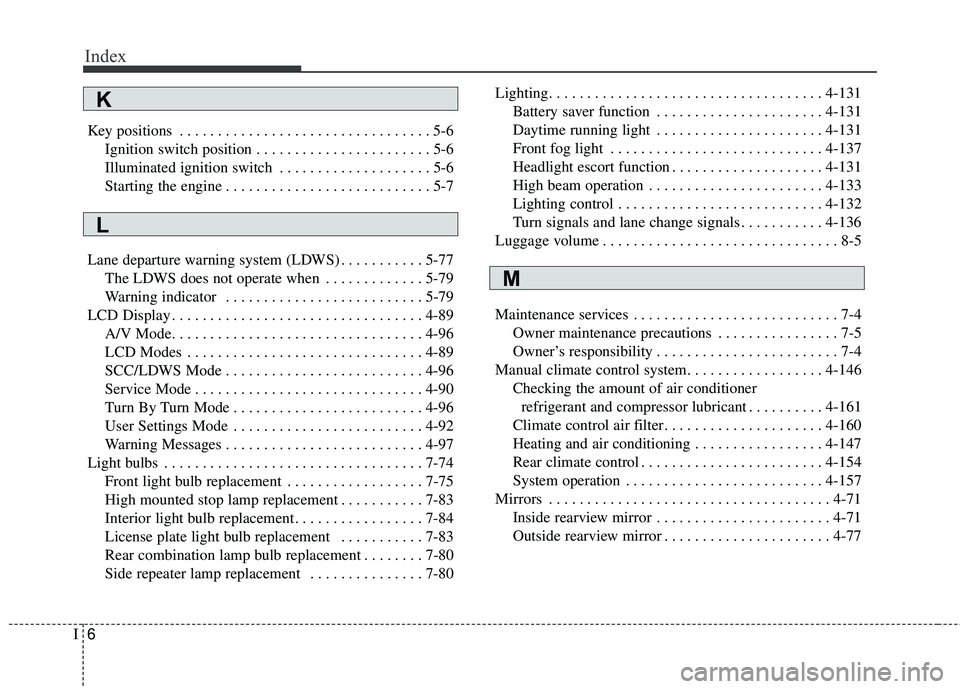
Index
6I
Key positions . . . . . . . . . . . . . . . . . . . . . . . . . . . . . . . . . 5-6Ignition switch position . . . . . . . . . . . . . . . . . . . . . . . 5-6
Illuminated ignition switch . . . . . . . . . . . . . . . . . . . . 5-6
Starting the engine . . . . . . . . . . . . . . . . . . . . . . . . . . . 5-7
Lane departure warning system (LDWS) . . . . . . . . . . . 5-77 The LDWS does not operate when . . . . . . . . . . . . . 5-79
Warning indicator . . . . . . . . . . . . . . . . . . . . . . . . . . 5-79
LCD Display . . . . . . . . . . . . . . . . . . . . . . . . . . . . . . . . . 4-89 A/V Mode. . . . . . . . . . . . . . . . . . . . . . . . . . . . . . . . . 4-96
LCD Modes . . . . . . . . . . . . . . . . . . . . . . . . . . . . . . . 4-89
SCC/LDWS Mode . . . . . . . . . . . . . . . . . . . . . . . . . . 4-96
Service Mode . . . . . . . . . . . . . . . . . . . . . . . . . . . . . . 4-90
Turn By Turn Mode . . . . . . . . . . . . . . . . . . . . . . . . . 4-96
User Settings Mode . . . . . . . . . . . . . . . . . . . . . . . . . 4-92
Warning Messages . . . . . . . . . . . . . . . . . . . . . . . . . . 4-97
Light bulbs . . . . . . . . . . . . . . . . . . . . . . . . . . . . . . . . . . 7-74\
Front light bulb replacement . . . . . . . . . . . . . . . . . . 7-75
High mounted stop lamp replacement . . . . . . . . . . . 7-83
Interior light bulb replacement. . . . . . . . . . . . . . . . . 7-84
License plate light bulb replacement . . . . . . . . . . . 7-83
Rear combination lamp bulb replacement . . . . . . . . 7-80
Side repeater lamp replacement . . . . . . . . . . . . . . . 7-80 Lighting. . . . . . . . . . . . . . . . . . . . . . . . . . . . . . . . . . . . \
4-131
Battery saver function . . . . . . . . . . . . . . . . . . . . . . 4-131
Daytime running light . . . . . . . . . . . . . . . . . . . . . . 4-131
Front fog light . . . . . . . . . . . . . . . . . . . . . . . . . . . . 4-137
Headlight escort function . . . . . . . . . . . . . . . . . . . . 4-131
High beam operation . . . . . . . . . . . . . . . . . . . . . . . 4-133
Lighting control . . . . . . . . . . . . . . . . . . . . . . . . . . . 4-132
Turn signals and lane change signals . . . . . . . . . . . 4-136
Luggage volume . . . . . . . . . . . . . . . . . . . . . . . . . . . . . . . 8-5
Maintenance services . . . . . . . . . . . . . . . . . . . . . . . . . . . 7-4 Owner maintenance precautions . . . . . . . . . . . . . . . . 7-5
Owner’s responsibility . . . . . . . . . . . . . . . . . . . . . . . . 7-4
Manual climate control system. . . . . . . . . . . . . . . . . . 4-146 Checking the amount of air conditionerrefrigerant and compressor lubricant . . . . . . . . . . 4-161
Climate control air filter. . . . . . . . . . . . . . . . . . . . . 4-160
Heating and air conditioning . . . . . . . . . . . . . . . . . 4-147
Rear climate control . . . . . . . . . . . . . . . . . . . . . . . . 4-154
System operation . . . . . . . . . . . . . . . . . . . . . . . . . . 4-157
Mirrors . . . . . . . . . . . . . . . . . . . . . . . . . . . . . . . . . . . . \
. 4-71 Inside rearview mirror . . . . . . . . . . . . . . . . . . . . . . . 4-71
Outside rearview mirror . . . . . . . . . . . . . . . . . . . . . . 4-77
K
L
M